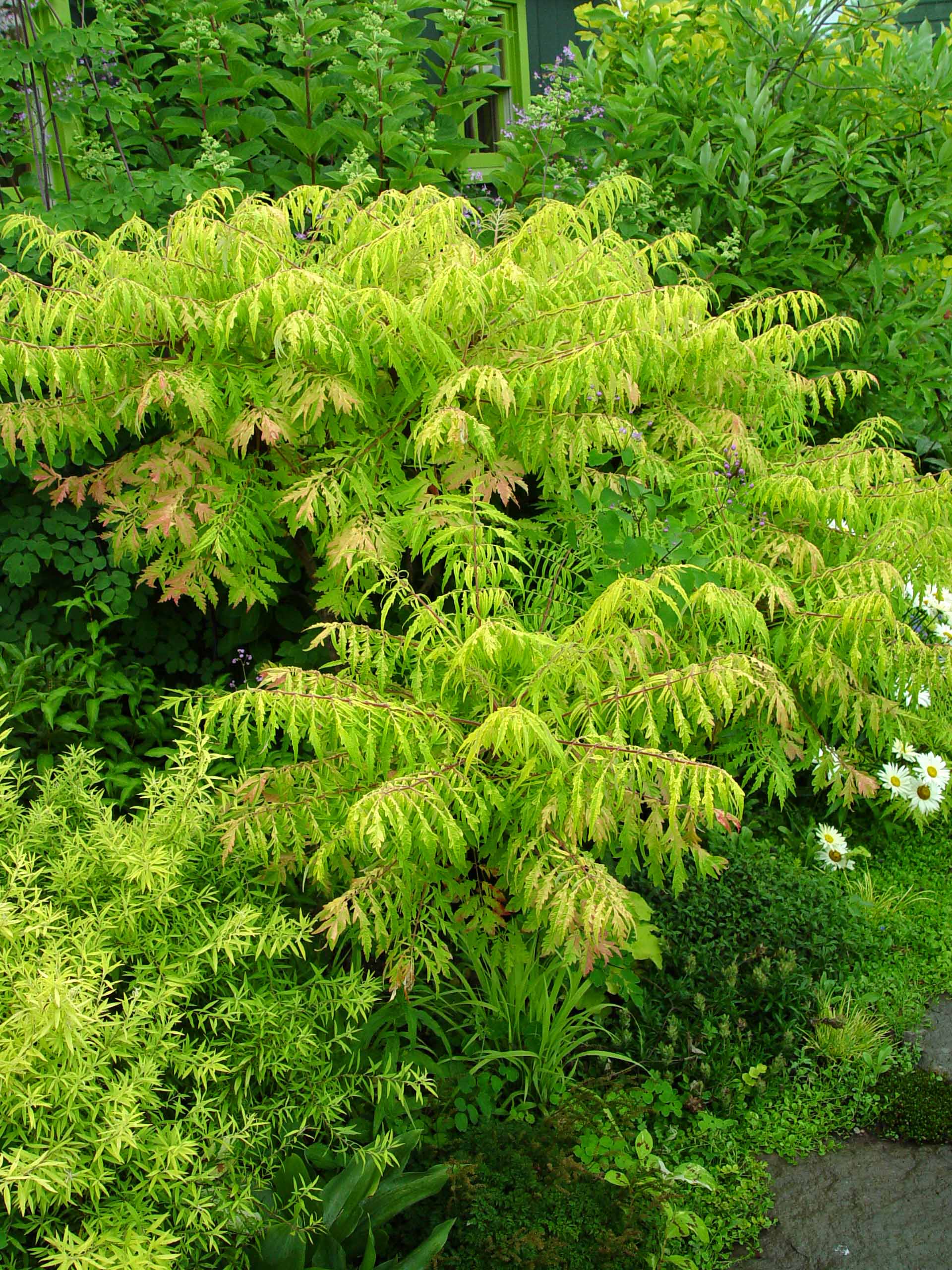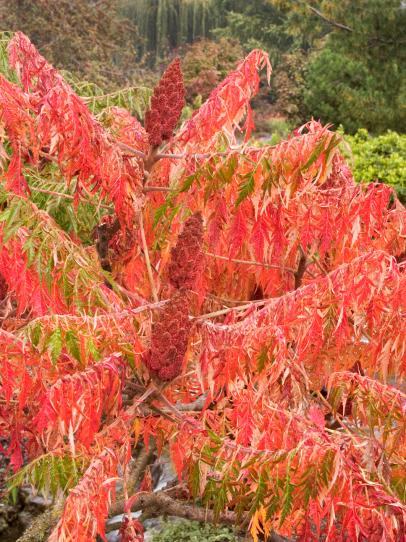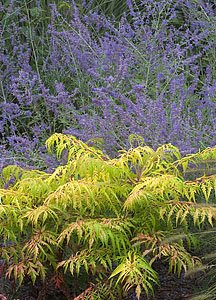is tiger eyes sumac poisonous
If its colorful foliage and elegant form dont do enough to recommend it its ease of care might. Sumac is a fairly common plant and you were probably taught for years that it is poisonous and should be avoided.

Fiddling Around In The Fall Garden Autumn Garden Fall Landscaping Garden Containers
It grows in many parts of the world in North America Europe Middle East and the Mediterranean.

. How fast do sumacs grow. Remember all you sumac-a-phobes this is a non-poisonous plant that thrives in poor well-drained soil and full sun. Heres the description of Tiger Eyes sumac from the PHS site.
While Poison Sumac is some nasty stuff the type of Sumac I used is not poisonous at all. The staghorn sumac Rhus typhina is a loosely formed shrub or weedy tree of fast growth rate which means it grows at. When it comes to sumac plants in the landscape Tiger Eyes sumac Rhus typhina Bailtiger hardy in US.
Is a tiger eye sumac poisonous. Prune this non-aggressive Sumac in early spring. Now however we are getting back to discovering the truth behind this plant.
The vast majority of people estimates range from 60-90 depending on your source react to contact with urushiol by developing a distinctive allergic rash with oozing blisters. It grows to about 6 feet tall and spreads very slowly. The Tiger Eyes staghorn sumac R.
It is considered to be a superior landscape plant to Laciniata as well as to the species Rhus. Poison sumac is one of a trio of plants poison ivy poison sumac and poison oak that produce an oil called urushiol which is a potent allergen. Foliage deciduous Flowering June to August.
It features striking yellow foliage that is a stunning addition to the landscape. Rhus typhina Tiger Eyes looks particularly good when used as a focal point in the. And CanadaThe species is not typically considered a good garden plant as it suckers rampantly can grow to 30 feet and is.
Excellent landscape specimen or accent. Tiger Eyes plants will slowly spread by suckering but it is not aggressive as is the case with species plants. There are 250 geniuses of Sumac which can grow anywhere from four to 35 feet in size.
A dwarf variety its said to be less invasive than the species. Poison sumac is not edible and like any foraged plant or shroom you should be 110 sure of what youve found before eating it. Tall with an umbrella habit as it matures stagorn or cutleaf sumac is a great choice for larger wilder landscapes.
It was discovered in a cultivated nursery setting in July of 1985 as a whole plant mutation of R. Height 16 feet 5 m Exposure full sun Soil ordinary. Tiger Eyes Sumac in early summer.
Highways and roads in. Tiger Eyes Sumac Cutleaf Staghorn Sumac shrub with chartreuse leaflets changing to yellow contrasting with pink stems. Department of Agriculture plant hardiness zones 4.
New growth is a lively chartreuse green quickly changing to yellow with both colors contrasting nicely with the rosy-pink leaf stems. Name Rhus typhina Family Anacardiaceae Type shrub. List of key staghorn tree facts.
The finely divided foliage is bright golden yellow turning orange and red before falling in autumn. There are several ornamental forms of sumac for planting in the garden landscape including Staghorn sumac Cutleaf sumac Fragrant sumac and smooth sumac. Do Cows Eat Sumac Tiger Eyes Related Questions How do you keep Tiger Eye sumac from spreading.
Tiger-eye Sumac Rhus typhina The Sumac itself is not a well-known variety for bonsai. Left to right Tiger Eyes Sumac Staghorn Sumac Smooth Sumac Shining Sumac foliage. After all until recently sumac poison ivy and poison oak were all classified under the same genus Rhus.
Tiger Eyes is a beautiful golden-leafed form of cutleaf staghorn sumac. This unusual Sumac has purplish-pink stems displaying exotic cut-leaf foliage. Tiger Eyes is more compact than the species and is not.
Staghorn sumac Rhus typhina a member of the Anacardiaceae cashew or sumac family is a scraggly-looking shrub commonly seen growing on roadsides and other disturbed areas through the eastern US. The best time to prune Tiger Eyes staghorn sumac is late winter or early spring. Additionally with the budding season approaching hard pruning encourages more vigorous bud.
TIGER EYES is a dwarf golden-leaved staghorn sumac cultivar that typically matures to only 6 tall and as wide. Staghorn sumac is a large treelike shrub native to the eastern edge of Minnesota Wisconsin and much of southeastern Canada. Foliage may take on scarlet orange coloring in the fall.
Tiger Eyes Sumac General Information. Tiger Eyes Sumac is a great variation of the common sumac. Tiger Eyes is bright lime green to yellow all summer turning brilliant bronzy red in fall.
Rhus typhina Bailtiger PP16185. From what I have seen Smooth Sumac is the most common species. The first reason is that most people act shocked when you mention Sumac because the first thing that comes to mind is Poison Sumac.
Poison sumac is a shrub or small tree differentiated from the common sumac staghorn sumac Rhus typhina growing along US. Typhina Bailtiger Tiger Eyes cultivar provides year-round color in US. Rhus typhina Tiger Eyes is a particularly attractive form of stags horn sumach.
Tiger Eyes Sumac In 2007 a new hybrid sumac was introduced to the garden trade by Baileys Nursery named Tiger Eyes sumac Rhus typhina Bailtiger. Yes some varieties are poisonous but many are not and its not difficult to distinguish them. Changing with each season Tiger Eyes starts out chartreuse in spring turns bright yellow in summer and blazes scarlet-orange in the fall.
Also effective when massed. New leaves emerge chartruese-green and change to a brilliant golden yellow as they mature. Staghorn sumac also called vinegar sumac is a short tree that grows in a roundish shape.
Tiger Eyes below is another staghorn selection thats getting a lot of press. In fall the color morphs again into a blazing shade of scarlet that you can see for miles. Staghorn Sumac Smooth Sumac and Shining Sumac are all native to Wisconsin.
The only task youll need to do is pruning. Birds love it and the fruits can be used for everything from dyes to. Prune when the canes are still leafless and before new buds begin to form.
The branches angle upward while the deeply cut leaflets drape downward. It features golden deeply cut leaves in summer that change to red and orange in fall. Department of Agriculture plant hardiness zones 4 through 8 just may take the cake.
Unlike its close relatives poison ivy oak and sumac the landscape sumacs do not cause itchy rashes. Its found very appealing for its fuzzy red fruit clusters but sometimes becomes.

Rhus Typhina Baitiger Tiger Eyes Sumac Plants Foliage Plants Shrubs

Sumac Tiger Eyes Garden Housecalls

Sumac Trees Are Unsung Garden Trees Hgtv

Tiger Eye Sumac Plants Ornamental Trees Shrubs

Plant Profile Tiger Eyes Sumac

Sumac And Its Uses Berries Forum At Permies

Tiger Eye Sumac Rhus Typhina Bonsai Soil Leaf Coloring Leaf Structure

Tiger Eyes Cutleaf Staghorn Sumac First Editions
Tiger Eyes Sumac Far Less Aggressive What Grows There Hugh Conlon Horticulturalist Professor Lecturer And Gardener

Tiger Eye Sumac Rhus Typhina Eschmidt Pa Bonsai Bonsai Soil Leaf Structure Sumac

Tiger Eyes Cutleaf Staghorn Sumac First Editions

Sumac Tree Lee Garden Evergreen Plants Gutter Garden

Tiger S Eye Sumac In My Neighbors Yard Is Lit R Marijuanaenthusiasts

Rhus Typhina Tiger Eyes Bailtiger Tiger Eyes Cutleaf Staghorn Sumac Plants Plant Life Garden Plants

Country Gardener Gold Medal Plant Tiger Eyes Sumac

A Sumac For All Seasons Knecht S Nurseries Landscaping

Tiger Eye Sumac Rhus Typhina Sumac Bonsai Soil Leaf Structure

Tiger Eye Sumac Rhus Typhina Leaf Structure Sumac Bonsai Soil
